[ad_1]
Using one of the best photo storage and sharing sites is vital if you have lots of photos. Whether you’re a pro photographer, an avid enthusiast or just like taking lots of casual pictures, storing them is becoming even more important than taking them.
With ever expanding sensor sizes and resolutions in the best cameras and best camera phones, RAW image files can now touch almost 100MB. These add up pretty quickly when taking lots of high quality photos, demanding more storage than your computer or phone may have. In such cases, cloud storage sites can provide plenty of space for your expanding catalogue.
The best photo storage sites also provide security and peace of mind, keeping your images safely backed up in the cloud, where you can access them whenever you have an internet connection. Photographers will also want to consider the organizational aspects of photo storage sites, as the tagging systems often featured make keeping track of images a breeze.
After testing all major services, we think the best photo storage and sharing site is Flickr. It offers a limited free plan, but its paid plan gives unlimited uploads, as well as touch-up tools, tagging features, a sharing platform and short video storage options. If you’re an Android and iPhone owner and just want an easy way to back up photos and video, you should check out Google Photos and iCloud, as these are both inexpensive ways to backup smartphone content. Whatever your needs, though, there’s sure to be a photo storage site for you; we’ve rounded up our favorites below.
The best photo storage and sharing sites today
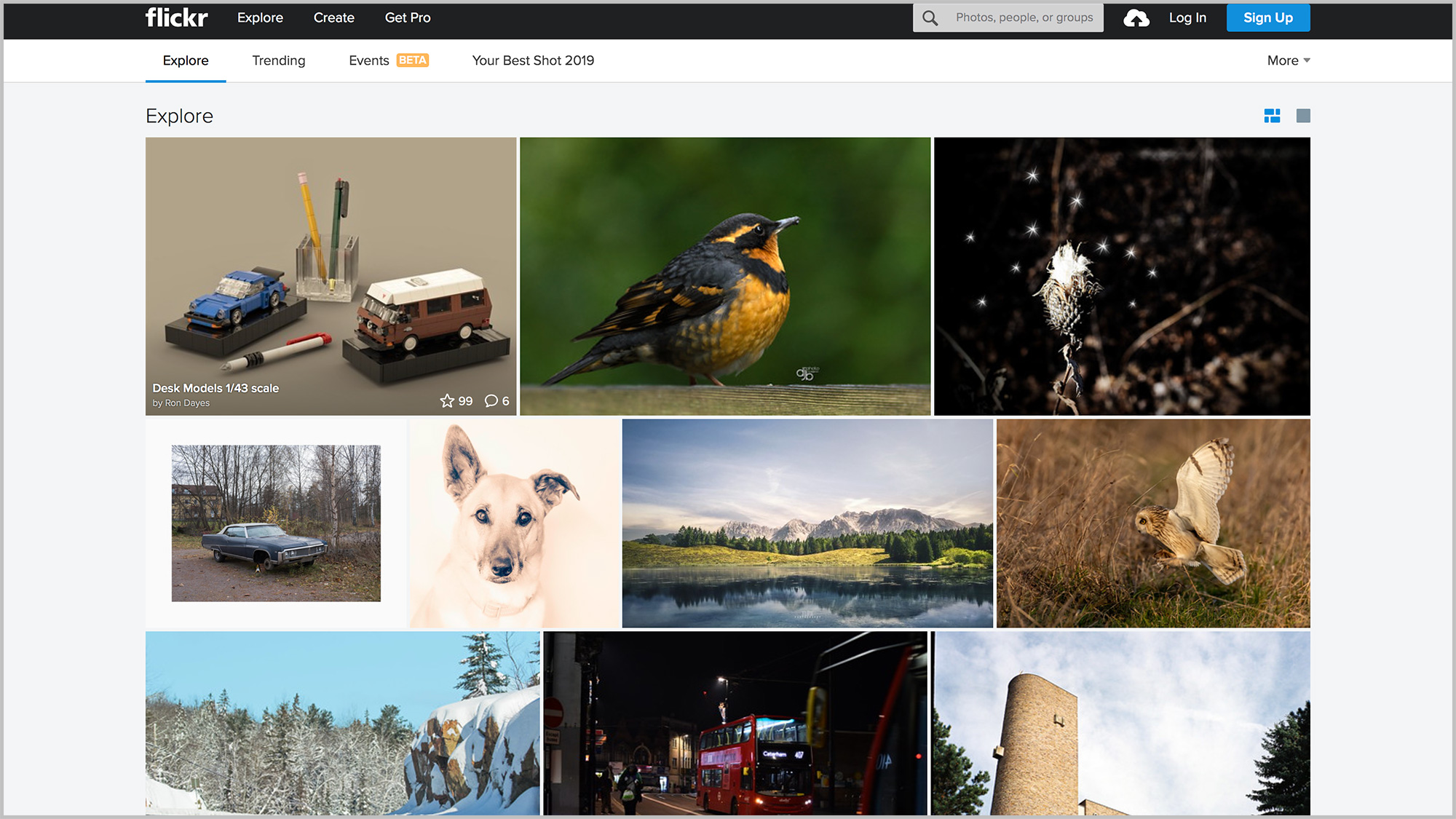

Flickr is our pick of the best photo storage and sharing sites, thanks to its massive amount of storage and a simple, clean interface that makes it a joy to use. It remains the best option for serious shooters. Flickr also offers a great selection of tools, extensive tagging features and support for both viewing and downloading photos at a variety of resolutions (including, unusually, the option to offer the original size). There’s even a stats engine that lets you track who is looking at your photos, while a very easy drag-and-drop system allows you to organize albums of your photos and collections of photos from you and other photographers.
Since being sold to SmugMug, the company announced a cap of 1,000 photos on free accounts. If you upgrade to a Pro account ($72 per year), you get unlimited storage, the ability to view your images at resolutions up to 6K, no ads and the option to stream videos up to 10 minutes in length. Pro subscribers also get $35 off a $70 order at photo-book service Blurb. (In our opinion, Blurb isn’t that great, so check out our picks for the best photo books). You also get 50% off the first year of a SmugMug subscription, among other bonuses.
Read our full Flickr review.
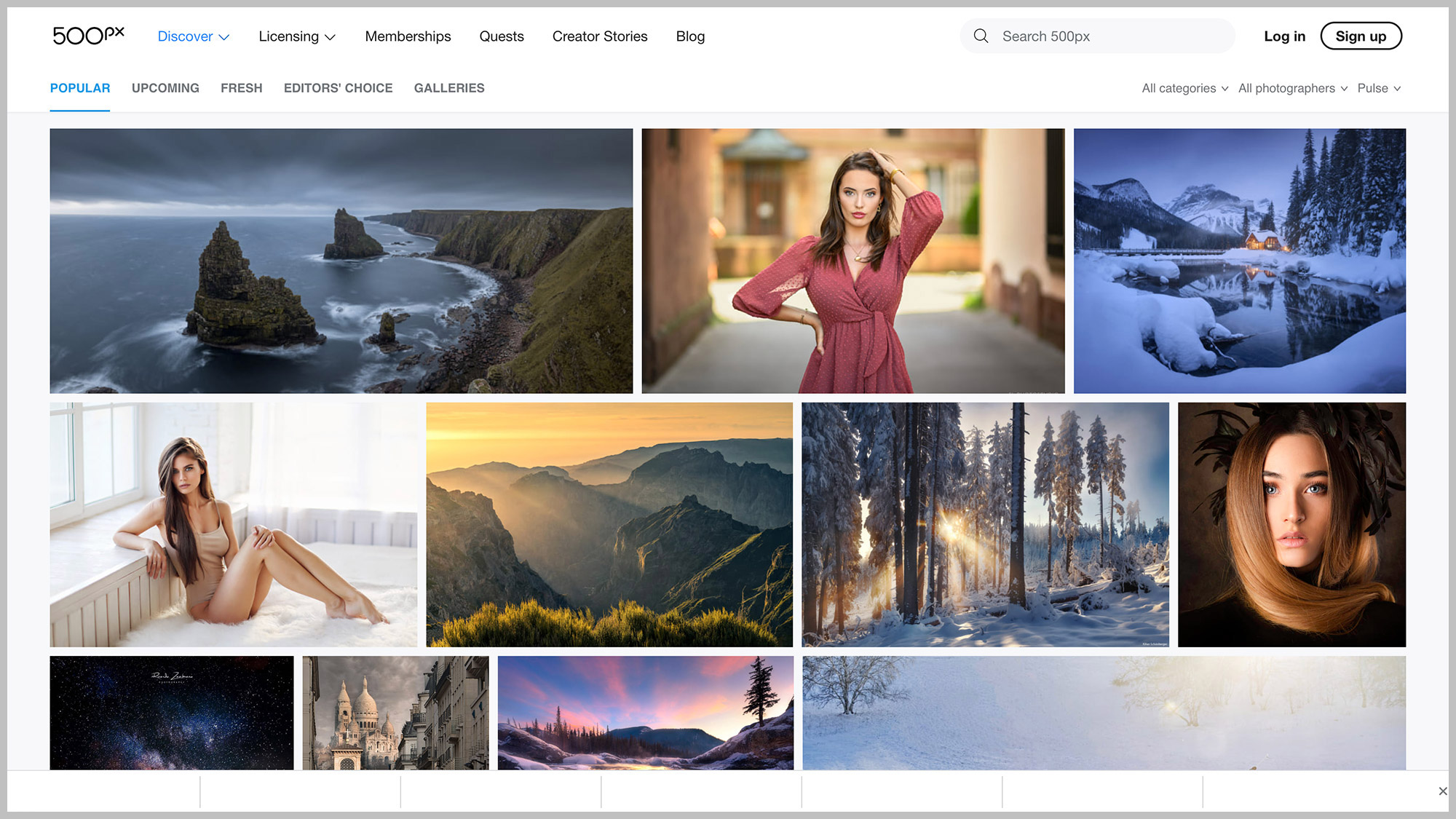
Aimed at serious photographers, 500px offers an image-focused design that puts your photos front and center, providing a clean and elegant way to display your best shots. You can organize your pictures into Sets (photos on a particular theme) and Stories (photos of an event) that present the images in a strikingly dramatic fashion.
The free version of the service allows you to upload up to seven photos per week, but you can upgrade to one of two paid levels for a reasonable fee: Awesome usually costs $4.99 a month, and Pro $9.99 a month, though the site is currently offering a discount on the first year (to $3.99 and $7.99/month). Both offer unlimited uploads, plus more customization options and listings in the sites’ pro directory. Whichever option you choose, 500px remains one of the best photo storage sites.
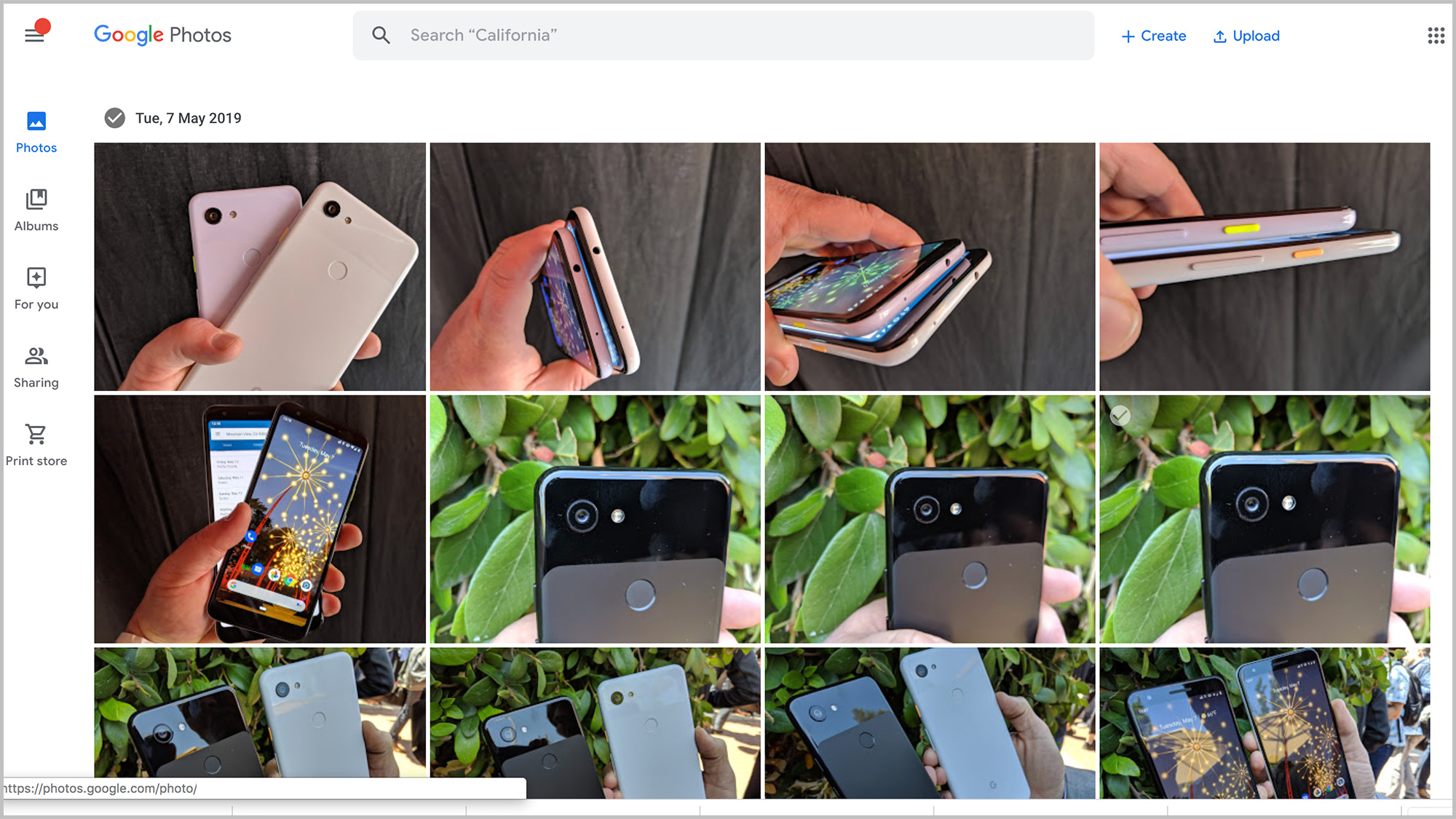
Google’s photo-sharing service was designed primarily as a way to back up photos and video taken on smartphones, but it has evolved into one of the smartest pieces of software in the entire Google ecosystem.
Google Photos uses AI to categorize your photos, making it super-easy to find the one you’re looking for. Type in “cat” for instance and it’ll search through them all and find every relevant photo (that could be a lot for some people). It will also identify people and group them together; once you give the group a name, you can then search for all photos featuring a particular family member or friend.
It’s also now a decent photo editing and sharing service. Once you’ve uploaded a photo, you can edit it by cropping and tweaking colors. Once the editing is done, you can create albums of photos and video that can be shared publicly or with specific Google users. In our roundup of the best photo editing software, we named Google Photos best for sharing. And, it’s available for both Android and iPhone users.
Google keeps adding new features too. For example, if Google Photos sees that a particular friend is in your photo, it will offer to share it with them. It can also automatically colorize black-and-white images, too. For more information, here’s our complete guide to Google Photos. If you have a Google Assistant-enabled smart display, such as the Google Nest Hub or the Google Nest Hub Max, you can also sync your Google Photos with the display, so they’ll show up on the screen.
Google Photos used to offer unlimited space and uploads, up to a maximum resolution of 16MP and video at 1080p. But these days, any photos you upload from a non-Pixel device will count against your free 15GB Google Drive limit. Anyone using a Pixel 2-5 will be unaffected, so long as they stick to High or Express quality uploads. If you want to store bigger images or video files, you’ll need to pay for space on Google Drive, which starts at $1.99 / £1.99 a month for 100GB.
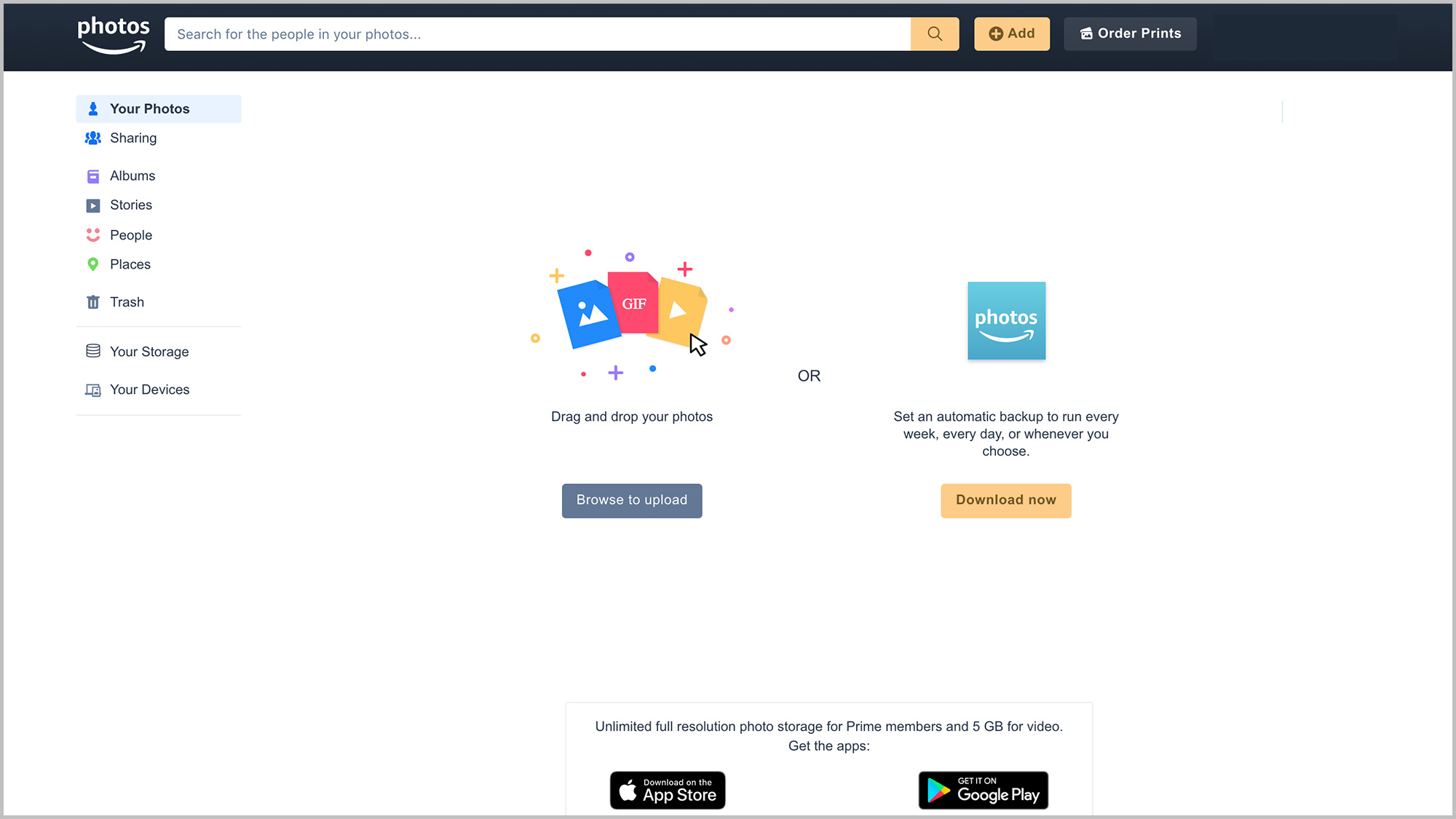
Amazon Prime Photos is Amazon’s photo storage site for Prime members. (Prime membership costs $139/ £95 year after a recent price hike.) The service lets you store and share unlimited photos on your desktop, smartphone or tablet, and automatically tags images and videos, such as by animal type, person, and location. You can also order photo prints, cards, calendars and more — all with free shipping. It’s too bad that Amazon Prints sits at the bottom of our best photo books list.
Users can invite up to five friends or family members to receive unlimited photo storage and collect photos in a Family Vault, and you can show photos on the Echo Show or Fire TV. That might be a good way to share the latest family snaps with the grandparents. Amazon has added a feature called Groups that allows you to share photos with a larger group, which is useful if you are involved in a club or society.
Read our full Amazon Photos review.

Apple’s iCloud service integrates with its own Apple Photos software on Macs and iOS devices, although you can use the basic features on a Windows PC. You can upload photos to the free 5GB of space and share them in an online photo stream that can be viewed in Apple Photos or as a web page. Photos can be tagged with names and locations, and other iCloud users can also add their photos. That’s a neat trick for creating a photo record from multiple photographers — say, of a party or concert everyone attended. Apple Photos will also identify and group images with similar faces, which you can tag with a person’s name and contact info.
If you run out of space, Apple offers three additional tiers: 50GB for 99 cents/month, 200GB for $2.99/month, and 2TB for $9.99/month. The latter two plans can be shared with other family members. Note also that Apple has now rolled out a feature to let iCloud users easily transfer photos and video to Google Photos — which might be worth checking out if you’re running short of space and haven’t already maxed out your Google storage.
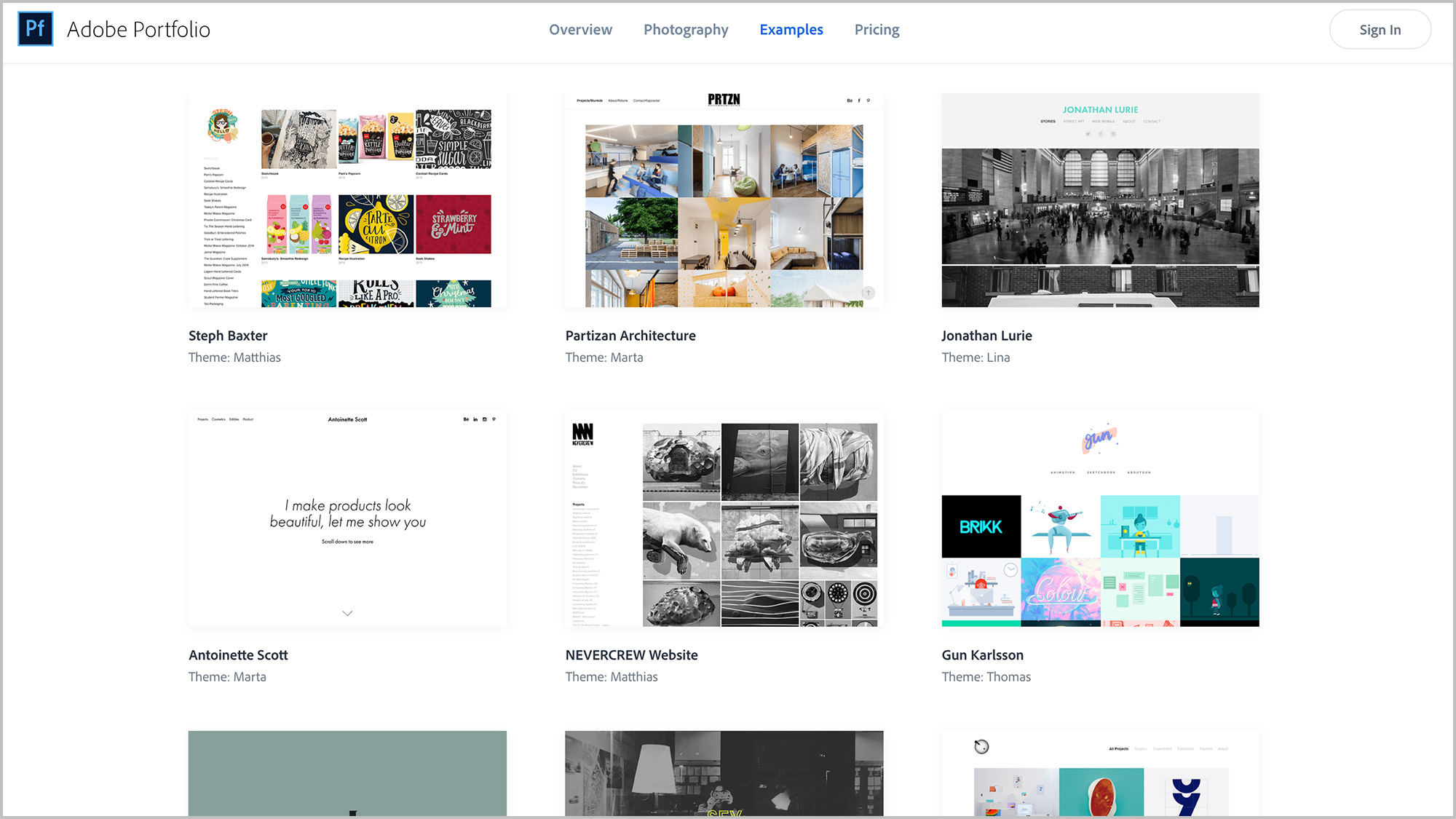
Adobe offers its Portfolio website creator and photo storage service to users of its Creative Cloud software subscription service, which provides access to programs like Photoshop and Lightroom.
The starting plan is $9.99/month and includes 20GB of storage, as well as Adobe Fonts, Photoshop and Lightroom. A Photoshop-only plan comes with 100GB of storage for $20.99/month, while a Lightroom-only plan with 1TB of storage is $9.99/month.
If you really want to splash out then the top-tier plan is $52.99/month, and includes 100GB of cloud storage, plus all of Adobe’s apps, including Illustrator, InDesign, Photoshop, Premiere Pro, After Effects, and more.
It’s well worth a try, particularly if you are already paying for a Creative Cloud subscription. Individual photos and events can be tagged and labeled with captions and the presentation is clean and easy to use — no surprise, given that it’s aimed at professional photographers marketing their services on Adobe’s Behance website. Still, it would also work well for amateurs looking for a clean, simple way to show off their work.
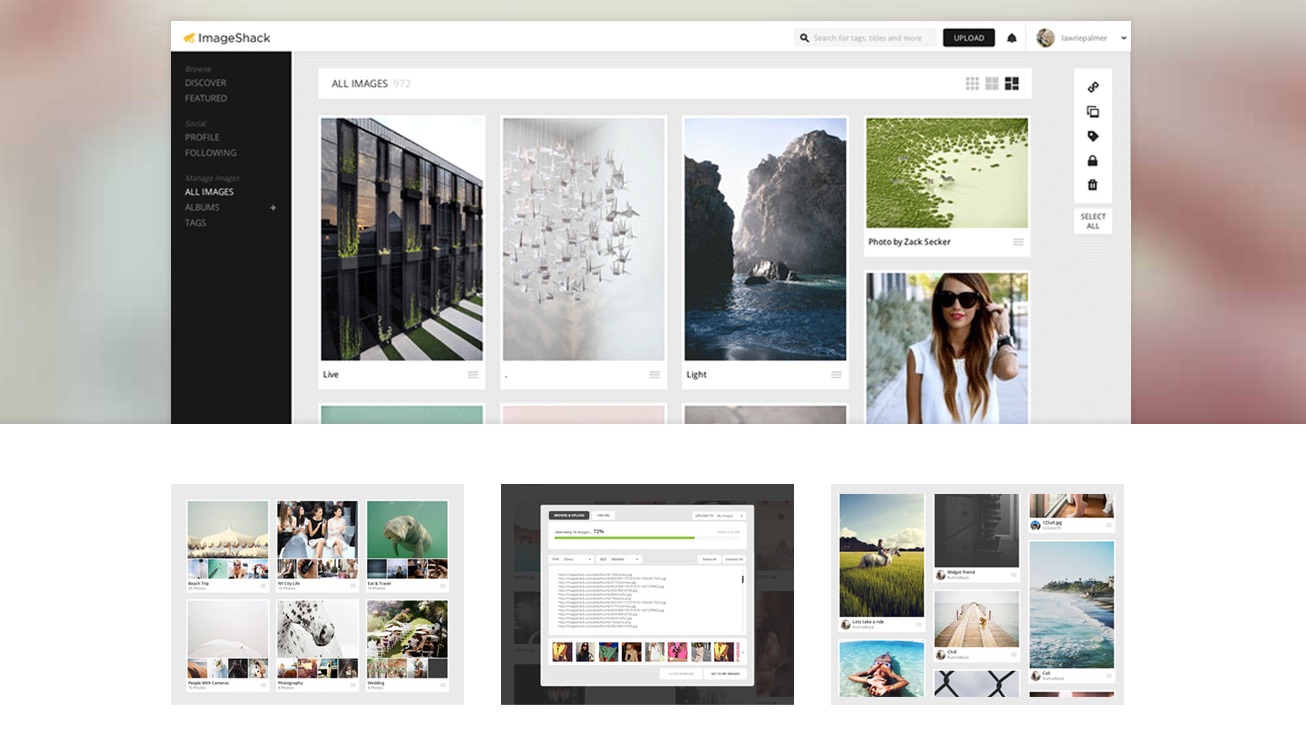
Although it lacks a free tier, ImageShack’s starting subscription — $3.99/month, or $37.99/year for unlimited photos — is pretty generous. With that, you also get the ability to watermark photos, embed photos, and share them. The Pro ($29.99/month) and Premium ($99.99/month) tiers add additional bandwidth for users to view and download your photos, plus dedicated support, a dynamic image resizer, and API access. Regardless of the plan, photos are limited to 25MB in size, which could be a hindrance to professional photographers.
ImageShack also lets you tag photos, and follow other photographers on its site. And another nice extra is that there are apps for Android, iOS, Mac, and Windows that let you automatically upload and back up photos to your ImageShack account.
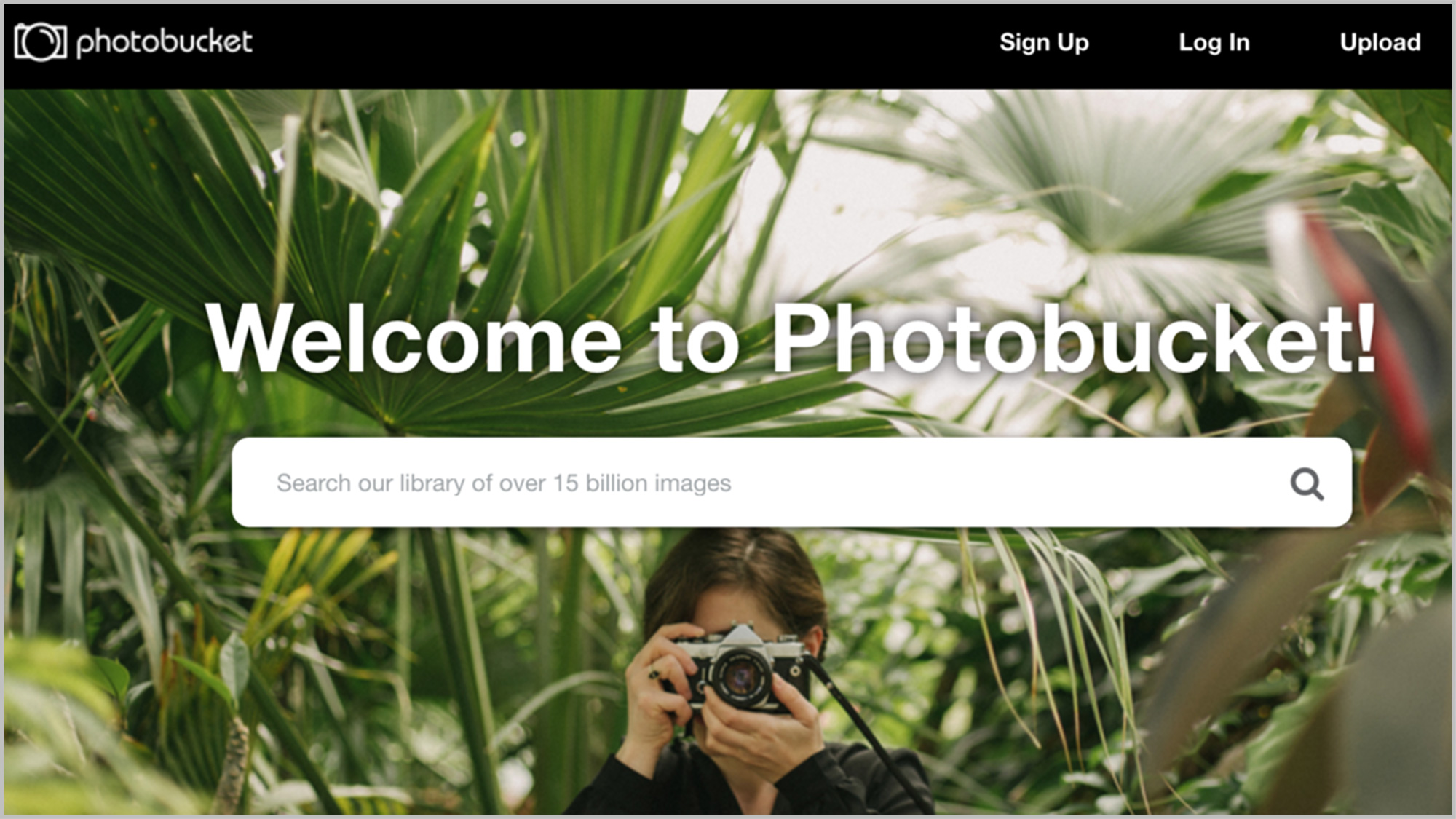
The free version of Photobucket offers photo storage for 250 photos, though it comes with very intrusive ads, including pop-ups that obscure your images. There are three levels of paid, ad-free service: Beginner (25GB of storage for $6/month), Intermediate (250GB for $8 a month) and Expert (unlimited storage for $13/month). If you pay for an annual subscription, the cost drops to $5.39/month for Beginner, $7.19 for Intermediate, and $11.69 for Expert.
All of these plans allow you to show the photos on a third-party site, which is useful if you want to put the photos on a social network site that doesn’t have its own image-uploading feature.
Photobucket has a generous collection of editing tools through a simple, easy-to-use interface. This list includes unusual tools like the smart color brush, which selectively adds color back into a black-and-white image.
Once you have edited your photos, you can add basic tags and organize them into albums or stories, the latter of which is a neat scrolling presentation of photos and accompanying text. Photobucket also provides extensive support for selling prints: you can buy individual photos, photo books (starting at $1.99) or even things like fleece blankets and tablet cases with your photos on them.
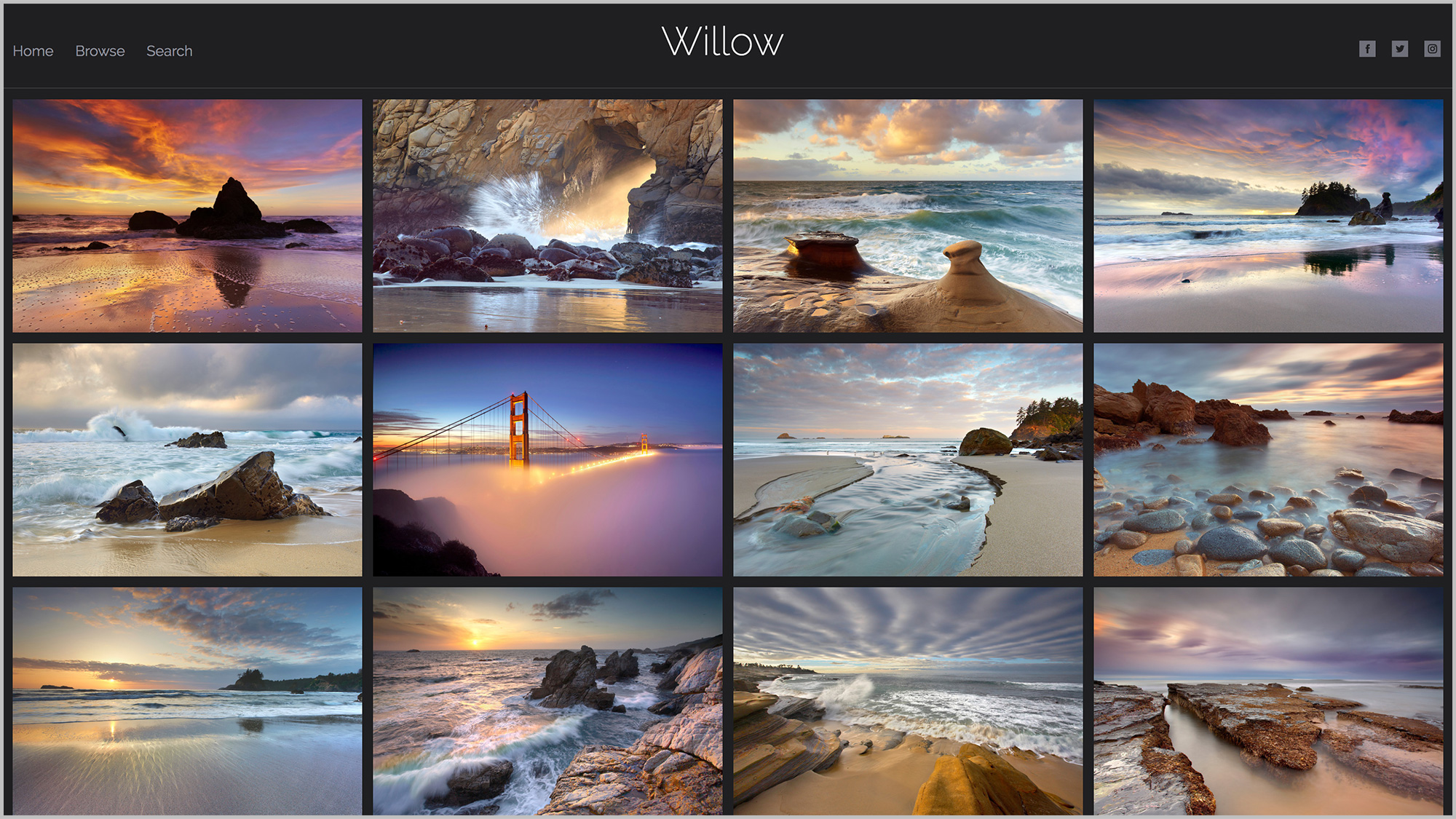
SmugMug is another design-focused photo storage site that offers a stylish home for your photos, with a custom homepage (such as richardb.smugmug.com) and many well-made design templates. Against that, SmugMug costs more than most of the services in our list. There is no free version (though there is a 14-day free trial) and the cheapest level costs $9 per month (or $75/year). That rises to $360/year for the Pro plan, which offers professional features such as ecommerce tools.
Regardless of the plan, you get a lot for your money, with unlimited storage of photos (each up to 500MB in size) and 1080p videos, and a good range of editing tools that are simple to use but powerful. These won’t replace Photoshop in a professional photographer’s toolbox, but they are good enough to fix most common photography issues and tweak a photo.
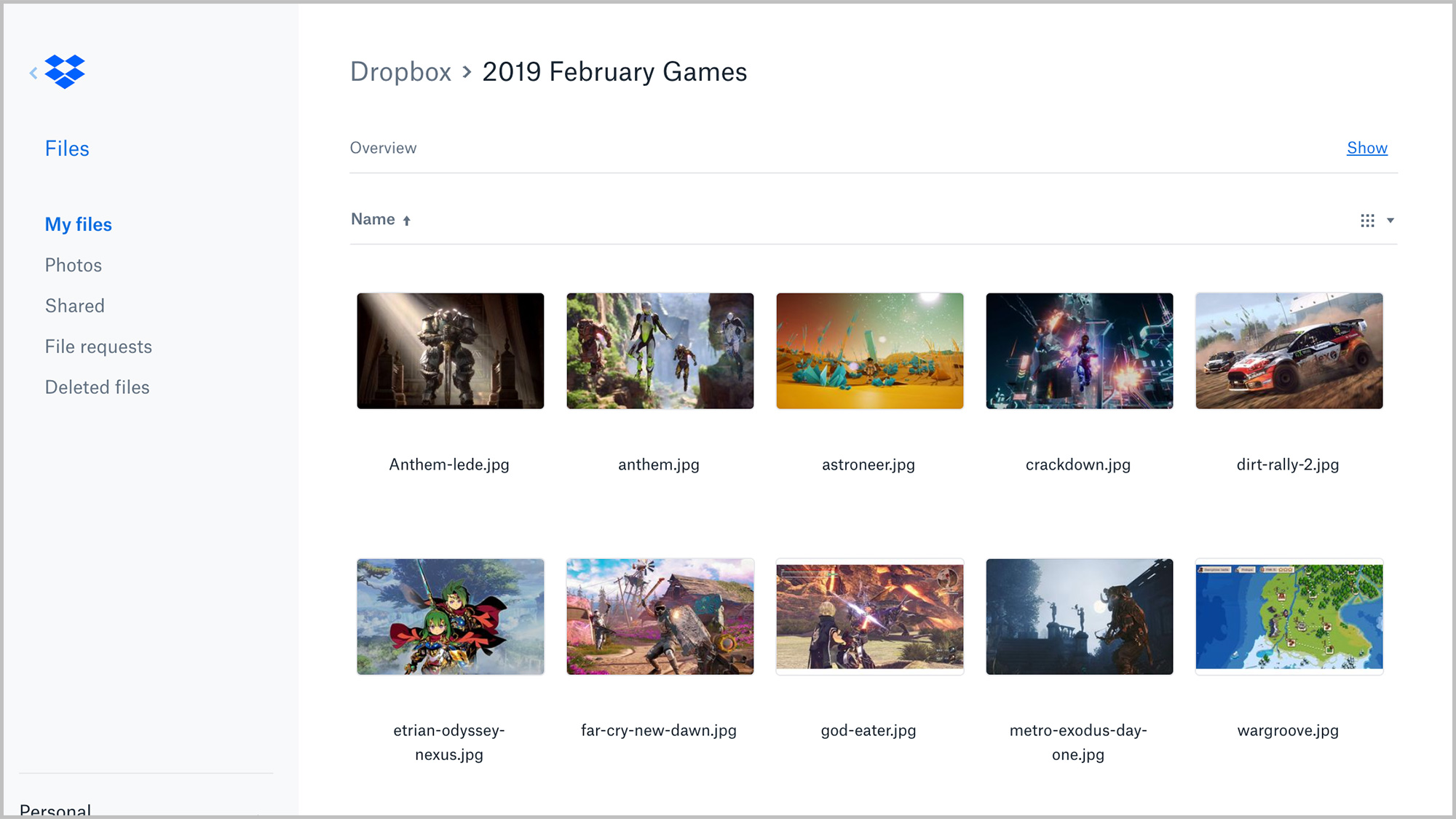
Dropbox offers support for photo storage, with its Android and iOS apps automatically uploading photos from mobile devices. You can also upload images from your computer to Dropbox as you would with any other files. Once photos are in the cloud, you can create and share basic slideshows that anybody can access, or share the files directly with other Dropbox users.
Unfortunately, there is no tagging, no printing and no way to edit photos online. Dropbox does offer a free collaborative editing tool, called Dropbox Paper, that is rather like Google Docs, but this doesn’t offer photo-editing features. As such, Dropbox is a good option for photographers who want to back up photos, but not for those who want to catalog and permanently store their images.
Dropbox offers a free 2GB plan; a 2TB plan costs $9.99/month, and includes 30 days of version history and file recovery. The Pro Plan ($16.58/month) gets you 3TB of storage, but 180 days of file recovery, as well as a host of other features. Here is a list of all of Dropbox’s storage plans.

The big kahuna of social sites also offers a surprisingly good set of photo storage, sharing and editing tools, with some caveats. After uploading photos from a cellphone, web browser or desktop client, you can create albums, add captions and tag photos by date, location or the people in the pictures. Face recognition has also been added; it will try to recognize the faces in your shots and tag those people if they are on Facebook. However, Facebook does shrink the images to fit onto the page; Facebook recommends sizing pictures to 720 or 960 pixels wide. You can use 2048-pixel-wide images if you select the high-quality upload option, but if the image is larger than 100 kb, it will get compressed for viewing.
Another downside is that there is no way to share the original-size photo. But if a lot of your family members and friends are already on Facebook, it’s a great way to share casual shots or family photos.
The 3 best general cloud storage services for photos right now
If you’re not so interested in the sharing, editing and organizing aspects of photo storage, and simply want a safe home for your digital images, you might be better looking at general cloud storage. We also have an article comparing cloud storage vs external hard disk drive so you can see what the advantages are.
You can view a full list on our best cloud storage for photos page, but we’ve included the top three here in case you want to jump straight to them.
How to pick the best photo storage site for you
To be considered one of the best photo storage sites, a service should offer six things:
- Value: It should have enough storage to keep all of your photos in one place over the years at a low cost.
- Quality: Your photos should be preserved in all their original high-res glory, not compressed beyond recognition.
- Ease of use: You need to be able to upload photos easily and edit them.
- Ease of access: Finding photos by date, tags or other means should be achieved without hassle.
- Shareability: A good photo site makes sharing photos as easy as taking them, allowing you to post pictures to sites like Facebook, Twitter and others.
- Printability: You or someone else who likes your photo should be able to buy a print or put together a photo book easily.
How much photo storage do you need?
In one sense, this question is impossible to answer: it obviously depends on how many photos you have, as well as on other factors such as which devices you use and which quality settings you shoot at.
However, we can give you some simple calculations, based on various average sizes of photos.
If you do most of your photography on a smartphone, your images are probably 4-10MB in size. Modern mirrorless cameras will usually run to more like 15-20MB and RAW files can be as big as 30-50MB. So, as a (very) rough estimate, that gives you:
| Device | 5GB | 10GB | 100GB | 250GB |
| Smartphone (10MB) | 500 | 1,000 | 10,000 | 25,000 |
| Mirrorless (20MB) | 250 | 500 | 5,000 | 12,500 |
| RAW (40MB) | 125 | 250 | 2,500 | 6,250 |
Even a (very rough) estimate like the above gives you an idea of the huge difference between the 5GB of free storage you get on Apple’s iCloud vs something like the 250GB you get with Photobucket’s Intermediate subscription.
But do also bear in mind that some services are based on number of photos rather than size — and if you mainly shoot with more space-hungry devices such as big-sensored mirrorless cameras and DSLRs, you might therefore be better choosing one of those (or something that offers unlimited storage)
Of course video is a different matter still, and is even harder to calculate due to length being yet another factor. Our suggestion here is to divide the file size by length of video for a given device to get an estimate for MB/minute, then work out roughly how many minutes’ footage you will want to store, then go from there. You might need a calculator for that one.
How we test photo storage sites
To find out which photo sites offer the best bang for your buck, we tested a number of them by uploading an assortment of photos from our camera reviews, tagging and organizing them as the site recommended. We also evaluated how well a site’s auto-tagging feature worked, if available, and looked at if a site stored our images at their full resolution.
We then looked at the various ways we could share and print photos, to determine which site offers the best and easiest-to-use range of features.
Also part of our evaluation was the cost of storage, for both free and paid tiers. While this wasn’t the determining factor — organizational and sharing features were given a higher priority — it did count in our overall rating. With all those factors considered, we were able to compile our list of the best photo storage sites.
If you’d like to do a little more reading before making your decision today, read about the 5 things to consider when selecting your next online storage provider and how to choose a cloud storage provider.
We have a wide range of buying guides to help you make the right decisions. If you’re also looking to edit photos, make sure you check out our photography guides, including the best photo editing software, best free photo editing software and best photo editing apps. If you’re a videographer, check out our guides on the best video editing software and best video editing apps. If you’re not keen on paying for your software just yet, why not read our guide to the best free video editing software. Only need to store images? You might also be interested in our guide to the best cloud storage for photos. And if you want to upgrade your gear, make sure you read our round up of the best cameras you can buy today.
[ad_2]
Source link






